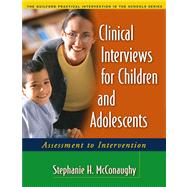Crafted to meet the day-to-day needs of school psychologists and other practitioners working with children, this is the most concise, practical, and up-to-date book of its kind. The author offers guidelines for interviewing children of different ages/m-/as well as their parents and teachers/m-/and for weaving the resulting data into multimethod assessment and intervention planning. Coverage encompasses school issues, peer and family relations, problem behavior, and more, with special chapters on assessing suicidality and violence risks. The book includes many detailed case illustrations and reproducible interview tools, in a convenient large-size format with lay-flat binding.
This book is in The Guilford Practical Intervention in the Schools Series.
This book is in The Guilford Practical Intervention in the Schools Series.








